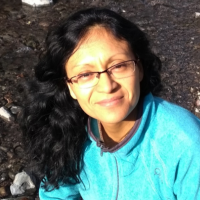Se encuentra usted aquí
Cristina Villamar

2022, Cristina A. Villamar; Katherine Salazar; Karla Montenegro-Rosero; Luis Huaraca; Kennedy C. da Conceicao. Preventive strategies for reuse and recycling of wastewater within the HDG production, Water Science and Technology.
2022, Montenegro-Rosero Karla, Villamar-Ayala Cristina, Fernández Lenys, Espinoza-Montero Patricio. Operational performance of corncobs/sawdust biofilters coupled to microbial fuel cells treating domestic wastewater, Science of The Total Environment.
2021, Cristina E. Almeida-Naranjo, Mayra Frutos, Jennifer Tejedor, Jeniffer Cuestas, Fabricio Valenzuela, María Inés Rivadeneira, Cristina Alejandra Villamar, Victor H. Guerrero. Caffeine adsorptive performance and compatibility characteristics (Eisenia foetida Savigny) of agro-industrial residues potentially suitable for vermifilter bed, Science of The Total Environment.
2020, J Tejedor, V Cóndor, CE Almeida-Naranjo, VH Guerrero, CA Villamar. Performance of wood chips/peanut shells biofilters used to remove organic matter from domestic wastewater, Science of The Total Environment.
2020, Chicaiza, C., Huaraca, L., Almeida, C., Guerrero, V., Villamar, C.A.. Improvement of organic matter and nutrient removal from domestic wastewater using intermittent hydraulic rates on earthworm-microorganism biofilters, Water Science and Technology.
2020, Huaraca, L., Chamorro, S., Hernández, V., Bay-Schmith, E., Villamar, C.A.. Comparative acute toxicity of glyphosate- based herbicide by Dapnia magna, Tisbe longicornis, and Emerita analoga, Journal of Environmental Science and Health, Part B.
2020, Almeida, C., Guachamín, G., Guerrero, V., Villamar, C.A.. Heliconia stricta Huber behavior on hybrid constructed wetlands fed with synthetic domestic wastewater, Water.
2019, Villamar, C.A., Carrera-Cevallos, J.V., Vasquez-Medrano, R., Espinoza-Montero, P.J.. Fate, eco-toxicological characteristics, and treatment processes applied to water polluted with glyphosate: A critical review, Critical Reviews in Environmental Science and Technology.
2019, Guerrero, J.A., Almeida, C.E., Villamar, C.A.. Improvement of nutrients removal from domestic wastewater by activated-sludge encapsulation with polyvinyl alcohol (PVA), Journal of Environmental Science and Health: Part: A.
2018, Villamar, C.A., Vera, I., Rivera, D., de la Hoz, F.. Reuse and recycling of livestock and municipal wastewater in Chilean agriculture: a preliminary assessment, Water.
2017, Almeida, C., Espinoza, P., Muñoz, M. and Villamar, C.A.. Hydraulic Retention Time influence on improving flocculation in the activated sludge processes through of polyelectrolytes, Water Air and Soil Pollution.
2016, Villamar, C.A., Rivera, D., Aguayo, M.. Anaerobic co-digestion plants for the revaluation of agricultural waste: sustainable location sites from a GIS analysis, Waste Management & Research.
2015, Villamar, C.A., Rivera, D., Neubauer, M.E., Vidal, G.. Nitrogen and phosphorus dynamics in a constructed wetland fed with treated swine slurry from an anaerobic lagoon, Journal of Environmental Science and Health: Part: A.
2014, Ortíz, G., Villamar, C.A., Vidal, G.. Odor from anaerobic digestion of swine slurry: influence of pH, temperature and organic loading, Scientia Agricola.
2014, Villamar, C.A., Silva, J., Bay-Schmith, E., Vidal, G. (2014). Toxicity Evaluation Identification of anaerobically treated swine slurry: a comparison between Daphnia magna and Raphanus sativus, Journal of Environmental Science and Health, Part B.
2014, Villamar, C.A., Neubauer, M.E., Vidal, G.. Distribution and availability of copper and zinc in a constructed wetland fed with treated swine slurry from an anaerobic lagoon, Wetlands.
2013, Plaza de los Reyes, C., Villamar, C.A., Neubauer, M., Pozo, G., Vidal, G.. Behavior of Typha angustifolia L. in a free water surface constructed wetlands for the treatment of swine wastewater, Journal of Environmental Science and Health: Part: A.
2013, Villamar, C.A., Rodríguez, D.C., López, D., Peñuela, M. and Vidal, G.. Effect of the generation and physical-chemical characterization of swine and dairy slurries on treatment technologies, Waste Management & Research.
2012, Neubauer, M.E. Plaza de los Reyes, C. Pozo, G. Villamar C.A. and Vidal, G.. Growth and nutrient uptake by Schoenoplectus californicus (C.A. Méyer) Sójak in a constructed wetland fed with swine slurry, Journal of Soil Science and Plant Nutrition.
2012, Villamar, C.A., Cañuta, T., Belmonte, M. and Vidal, G.. Characterization of swine wastewater by Toxicity Identification Evaluation Methodology (TIE), Water Air and Soil Pollution.
2012, Pozo, G., Villamar, C.A., Martinez, M. and Vidal, G.. Effect of organic load and nutrient ratio on the operation stability of the miving bed bioreactorfor kraft mill wastewater treatment and incidence of polyhydroxyalkanoare biosynthesis., Water Science and Technology.
2011, Pozo, G., Villamar, C.A., Martinez, M. and Vidal, G.. Polyhydroxyalkanoate (PHA) biosynthesis from kraft mill wastewater: biomass origin and C:N relationship influence, Water Science and Technology.
2021, Desarrollo de tecnología de biofiltración para el tratamiento de aguas residuales y la generación de subproductos con valor agregado, Director, Transfiere DGT.
2020, Estudio de la permanencia, interacción y tratamiento de contaminantes emergentes y microorganismos patógenos procedentes de aguas residuales domésticas, Investigador responsible, Postdoc 092118VA.
2019, Incidence of Biofiltration processes on the Removal of Pharmaceutical and Personal Care Products from Domestic Wastewater, Director, Fondecyt 11190352.
2019, Evaluación estacional del potencial de revalorización de subproductos procedentes de biofiltros híbridos alimentados con aguas residuales domésticas, Director, Proyecto 091918VA.
2019, Estudio de la remoción de contaminantes emergentes usando residuos agroindustriales dentro de procesos de filtración como alternativa de saneamiento, Investigador colaborador, Proyecto PIS-18-01.
2016, Biogas from Slaughterhouse Waste Water treatment for Heating Purpose, Investigador colaborador, Proyecto CIMNE-INER-EPMRQ.
2016, Análisis de la sensibilidad de los caudales ecológicos en el páramo a las variaciones del clima. Caso de estudio del Sistema de Captación La Mica en el volcán Antisana, Investigador colaborador, Proyecto PIMI-1406.


